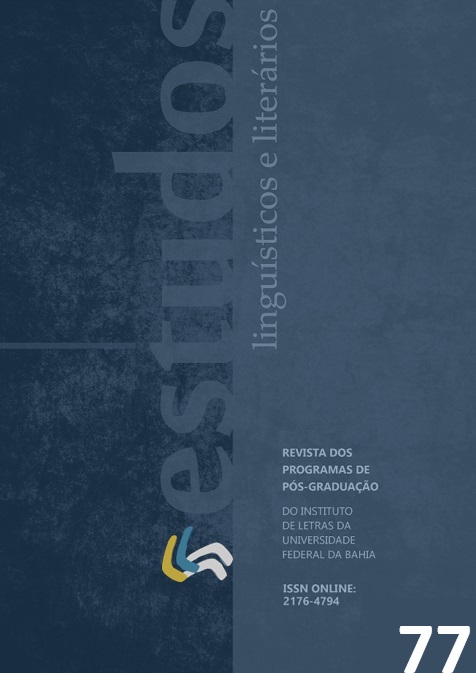TOWARDS A PROPOSAL FOR THE ANALYSIS OF SPATIAL VERBS IN BRAZILIAN SIGN LANGUAGE (BSL)
DOI:
https://doi.org/10.9771/ell.v0i77.61682Keywords:
Sign Language – Libras; Spatial verbs; Agreement verbs; Directional movement; Spatial syntax.Abstract
This work investigates the semantic and morphosyntactic properties of spatial verbs in Brazilian Sign Language (Libras), in comparison with agreement verbs, specifically with regard to the role of directional movement (DIR) in encoding arguments in the syntactic structure of sentences. We consider, with Meir (2002), that: the directional movement identifies thematic roles, while the orientation of the palms identifies the internal dative argument; the opposition between body and space depicts the grammatical category of person (1p versus non-1p) or other locations in space. The corpus consisted of a set of sentences with verbs of movement, elicited according to the semantic classification made by Levin (1993). Data analysis showed that there are morphosyntactic differences regarding the phonological parameters on spatial verbs and agreement verbs, resulting in the following proposal: spatial verbs in Libras are simple agreement verbs, having only one feature [location] to be valued in the syntactic derivation (Lourenço, 2018a,b and following); when used with dative arguments, spatial verbs have a complex structure that combines a simple agreement verb with the dative phrase, introduced through a relational head (Mesquita, 2019); the features [location] and [person]/[number] integrate the bundle of phi-features of the head D0 and correspond, respectively, to the directional movement and the orientation of the palms.
Downloads
References
CAPOVILLA, Fernando César; RAPHAEL, Walkíria D. Dicionário enciclopédico ilustrado trilíngue da língua de sinais brasileira. Volume I: Sinais de A a L. São Paulo: Edusp. 2001a.
CAPOVILLA, Fernando César; RAPHAEL, Walkíria D. Dicionário enciclopédico ilustrado trilíngue da língua de sinais brasileira. Volume II: Sinais de M a Z. São Paulo: EdUSP. 2001b.
FERREIRA-BRITO, Lucinda; LANGEVIN, R. Sistema Ferreira Brito-Langevin de transcrição de sinais. In: FERREIRA-BRITO, Lucinda (Org.). Por uma gramática das línguas de sinais. Rio de Janeiro: Tempo Brasileiro, 1995.
FIGUEIREDO, Lorena M. B.; LOURENÇO, Guilherme. O movimento de sobrancelhas como marcador de domínios sintáticos na Língua Brasileira de Sinais. Revista da Anpoll, v. 1, n. 48, p. 78-102, 2019.
LEVIN, Beth. English verb classes and alternations: a preliminar investigation. Chicago: University of Chicago Press, 1993.
LILLO-MARTIN, Diane C.; MEIER, Richard P. On the linguistic status of ‘agreement’ in sign languages. Theoretical linguistics, v. 37, n. 3/4, p. 95–141, 2011.
LOURENÇO, Guilherme. Verb agreement in Brazilian Sign Language: Morphophonology, Syntax & Semantics. 2018a. Tese (Doutorado em Linguística Teórica e Descritiva) –Universidade Federal de Minas Gerais, Belo Horizonte.
LOURENÇO, Guilherme. Layering de informações visuais e a estrutura morfofonológica dos verbos em Libras. In: Congresso Nacional de Pesquisas em Linguística e Libras, 2, 2018, Florianópolis. Anais. Florianópolis, 2018b.
MEIR, Irit. Thematic structure and verb agreement in Israeli Sign Language. 1998. Ph.D. Dissertation –Hebrew University of Jerusalem, Jerusalém.
MEIR, Irit. A cross-modality perspective on verb agreement. Natural language & linguistic theory, v. 20, p. 413-450, 2002.
MEIR, Irit; PADDEN, Carol; ARONOFF, Mark; SANDLER, Wendy. Rethinking sign language verb classes: The body as subject. In: QUADROS, Ronice Müller de (Org.). Verb agreement in Brazilian Sign Language. Petrópolis: Arara Azul, 2008, p. 365-387.
MESQUITA, Aline C. R. Estruturas dativas do português (L2) na interlíngua de surdos. 2019. Tese (Doutorado em Linguística) – Universidade de Brasília, Brasília.
PADDEN, Carol. Interaction of morphology and syntax in American Sign Language. New York/London: Garland Publishing, [1983] 1998.
QUADROS, Ronice Müller de; KARNOPP, Lodenir. Língua de sinais brasileira: Estudos linguísticos. Porto Alegre. Artes Médicas. 2004.
QUADROS, Ronice Müller de; QUER, Joseph. A caracterização da concordância nas línguas de sinais. In: LIMA-SALLES, H.; NAVES, R. (Orgs.). Estudos gerativos da língua de sinais brasileira e de aquisição do português (L2) por surdos. Goiânia: Cânone Editorial, v. 1, 2010.
SANDLER, Wendy. The phonological organization of sign languages. Lang linguist compass, v. 6, n. 3, p. 162-182, 2012. DOI:10.1002/lnc3.326.
SILVA, Keyla Maria Santana da. Um estudo sobre as propriedades morfossintáticas e semânticas dos verbos espaciais em Língua de Sinais Brasileira. 2023. Tese (Doutorado em Linguística) – Universidade de Brasília, Brasília.
SUPALLA, Ted. Acquisition of verbs of motion and location in ASL. 1982. Unpublished Doctoral Dissertation – University of California, San Diego.


